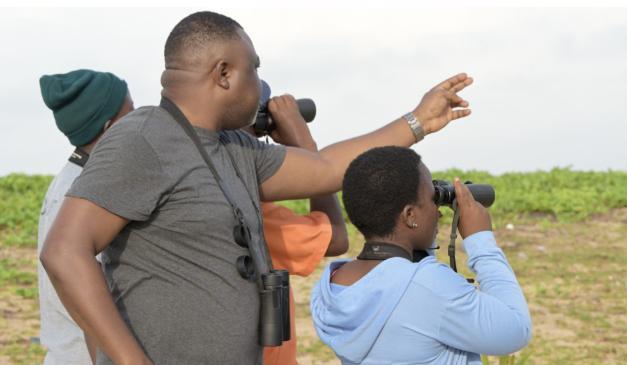Africa-Press – Liberia. On a rainy morning eight years ago, a group of nature enthusiasts woke up early on a Sunday morning to look for birds. The gathering, organised by the Society for the Conservation of Nature of Liberia (SCNL), was supported by the then-German ambassador’s wife.
Since that day, at 6AM on the second Sunday of every month, they try to meet in a different location, usually somewhere near or in Monrovia. Together, they document which bird species they see. And they share their findings with their partners, BirdLife International.
On June 8th 2025, they gathered to celebrate the eighth anniversary near a lagoon in Congo Town. The group made their way to a dune sandwiched by the sea and the lagoon. Leading the walk along with colleagues was Emmanuel M. Lokueh, research officer at SCNL and leader of the bird watching group. Turning to the group, he listed out features they should be watching out for, “the coloration, the calls, the movement… then the eye of a bird…these are the techniques you use to identify birds.”
The project joins a citizen science tradition that has millions of contributors around the world. Nature enthusiasts use apps like eBird, Merlin and iNaturalist to document the species they observe around them. iNaturalist has 3.7 million citizen observers globally, 140 of which have made observations in Liberia. Merlin has 7.5 million. Anyone can download and contribute to these apps.
Scientists can use such observations submitted on these apps to study changes in biodiversity, the impacts of climate change, urban wildlife and so much more. The research isn’t limited to bird watching, citizen scientists contribute to other areas of science like weather, plants and other animals including sea creatures and insects.
Liberia has a rich biodiversity, even in its urban areas. A list compiled by citizen scientists on eBird shows that more than 300 bird species have been identified in Montserrado county. Woodland kingfishers, common bulbuls, red-eyed doves and rollers are frequently seen on the streets and electricity lines in Monrovia.
But that number is only a partial picture. In total, Liberia is said to host over 536 bird species, according to BirdLife International. This includes migratory birds, land birds, water birds and sea birds. Sixteen of Liberia’s bird species are considered threatened.
Science and conservation organizations use labels such as threatened or vulnerable to signal how close species are to extinction. Every year, thousands of species go extinct and conservation efforts are geared to try and slow down that decline in biodiversity.
Each animal plays a small but significant role in keeping a habitat healthy. But in order to conserve birds, we first need to know the ground reality of their numbers — where a species can be found and how many individuals are left.
“There are some birds that love cities, they are no longer in the forest,” said Lokueh. “So we want to have data on the kind of species.”
Volunteers joining SCNL document the bird species they see on the BirdLasser app. Walking alongside a lagoon in Congo Town on the day of their anniversary, they spotted 10 different species. Pied kingfishers hovered in the air before diving into the water to catch fish. Cormorants dried their wings on the edge of the water. As the volunteers wound up the walk, participants reminisced not just about the birds, but about the eight-year-long journey to better understand the state of birds of Liberia.
For More News And Analysis About Liberia Follow Africa-Press






